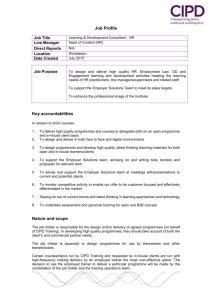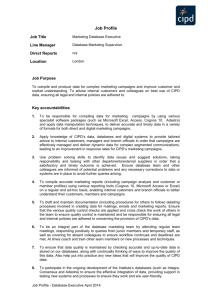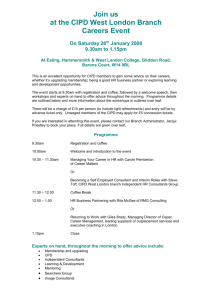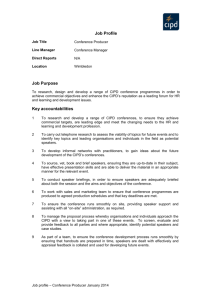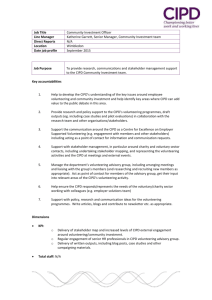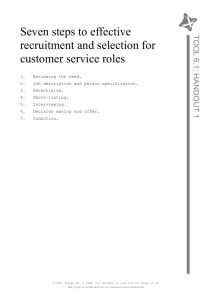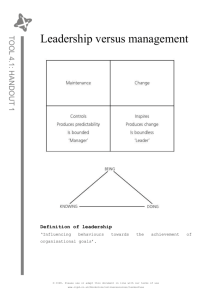Building an excellent reputation
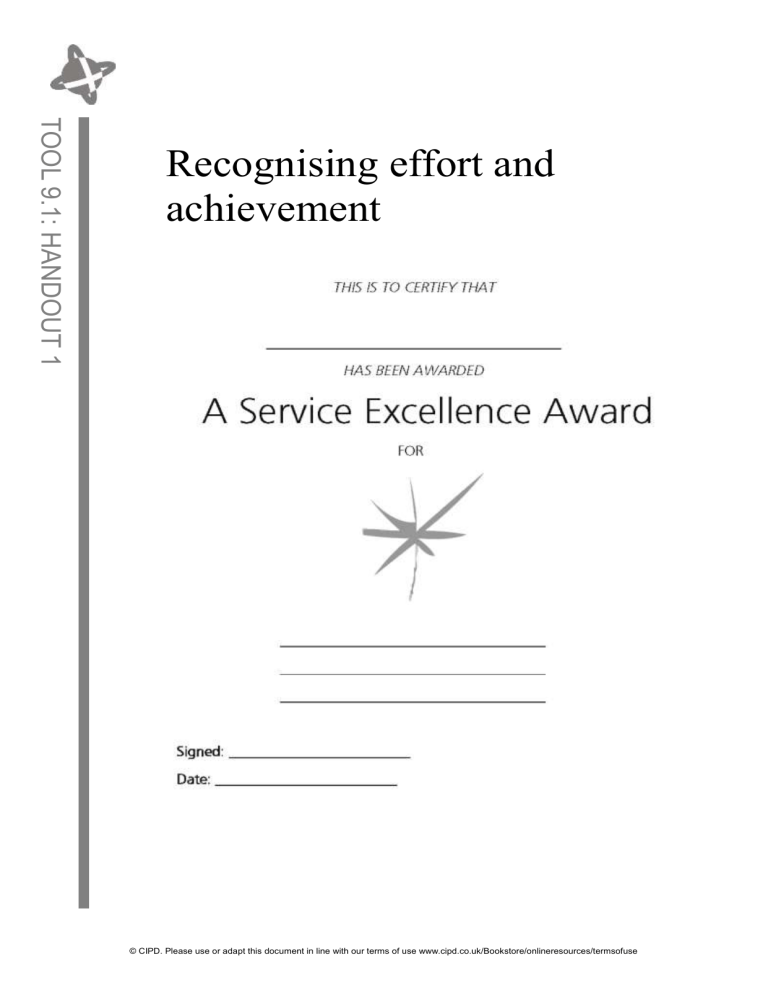
Recognising effort and achievement
© CIPD. Please use or adapt this document in line with our terms of use www.cipd.co.uk/Bookstore/onlineresources/termsofuse
Reward and recognition: selfreflection
Write below how you currently reward and recognise your team members for excellent service.
Consider how successful you are at this.
How do you know if this is successful?
What can you do differently?
© CIPD. Please use or adapt this document in line with our terms of use www.cipd.co.uk/Bookstore/onlineresources/termsofuse
•
Competitive analysis
Who are your main competitors?
• What products and/or services do they offer which are similar to your own?
•
How are these products and/or services delivered (ie face to face, via the phone, via the Internet etc)?
© CIPD. Please use or adapt this document in line with our terms of use www.cipd.co.uk/Bookstore/onlineresources/termsofuse
Benchmarking
What is benchmarking?
Benchmarking is the process of comparing practices and procedures in order to identify outstanding performance and learn from this in order to bring about improvement.
Benchmarking was originally developed by companies operating in an industrial environment. In recent years, organisations such as government agencies, hospitals and universities have also discovered the value of benchmarking and are applying it to improve their processes and systems.
How does benchmarking help measure customer service?
In a customer service environment no business can afford to be complacent.
Customers’ expectations are rising. Customers’ experiences of service quality are not just formed by dealings with one industry or sector; what happens on the high street, online, with ones bank, in a restaurant, on holiday, at the gym and many other customer ‘touch points’ influences people’s expectations of service.
Products and services can now easily be replicated and sustained competitive advantage is becoming harder to attain. Customer service professionals need to take a wider perspective of what is happening in the marketplace rather than being restricted to their own area of expertise. By measuring your own, other parts of the organisation and different organisations’ customer service practices and procedures, you can improve your own levels of service.
Benchmarking:
• Provides a greater awareness of the quality of service that your organisation provides.
• Allows individuals to see their service from a customer’s perspective.
• Helps set performance goals.
© CIPD. Please use or adapt this document in line with our terms of use www.cipd.co.uk/Bookstore/onlineresources/termsofuse
•
•
•
Brings about improvement in processes and practices.
Increases efficiency.
Enhances customer satisfaction.
Types of benchmarking
There are four main types of benchmarking that you can undertake to measure customer service:
1. Internal.
2. Competitive.
3. Non-competitive.
4. Best in class.
Internal benchmarking
This involves making comparisons within your own business. There may be parts of your organisation that adopt similar processes or procedures with whom you can share information and make comparisons.
Competitive benchmarking
This is where businesses measure competitor’s service, for example via mystery shopping their business, via questionnaires and surveys.
Non-competitive benchmarking
Here a business identifies other companies who, although they may not have the same customer base, deal with similar situations or adopt similar processes.
Organisations can learn from them although they work in a non-competitive field.
Best in class
There are certain organisations who over the years offer consistently high levels of customer service. These businesses are considered ‘best in class’.
© CIPD. Please use or adapt this document in line with our terms of use www.cipd.co.uk/Bookstore/onlineresources/termsofuse
They are used as a benchmark of best practice by other service organisations, who, although they may not be able to replicate exactly the style of service that the star organisations demonstrate, can still learn from them and be inspired to greater things.
The benchmarking process
Benchmarking should be a systematic and well thought out process. If it is done properly it is not industrial tourism or measurement for measurement’s sake.
There are six steps in the benchmarking process:
Step 1 involves gaining in-depth knowledge of the processes or practices that you wish to benchmark. This involves mapping out exactly what happens when, who is involved and how long each step takes. Unless you have this type of information it is difficult to make direct comparisons.
© CIPD. Please use or adapt this document in line with our terms of use www.cipd.co.uk/Bookstore/onlineresources/termsofuse
Step 2 is agreeing what you want to benchmark and with whom. It is helpful to work with a project team to manage the project and the team will need to decide who you want to approach as benchmarking partners. At this stage too it is useful to decide how you will collect the comparative data, eg face-to-face visits, observation, telephone surveys, questionnaires.
Step 3 involves collecting the data required to make comparison between your own and other organisations. Here it is important to agree the key metrics that you will use that can apply to all organisations taking part in the benchmarking study. Also, the benchmarking working party needs to be conscious of the differences that cultural influences may have in collecting data.
Step 4 is analysing the data. It is important that this is in a format that allows you to make comparisons such as those shown in the table below.
Criteria
Number of steps in the process
Number of people involved
Overall time taken
Your company
12
7
15 days
Company 1
10
6
12 days
Company 2
8
4
10 days
Company 3
5
3
6 days
In this way gaps in performance can be identified and improvement areas agreed.
Step 5 involves action planning and implementing the improvements.
Step 6 is reviewing the outcomes of the improvements.
© CIPD. Please use or adapt this document in line with our terms of use www.cipd.co.uk/Bookstore/onlineresources/termsofuse
Communications checklist
Use this checklist to assess how well you personally communicate the importance of service excellence in your area.
Rate your agreement on a scale of strongly disagree to strongly agree. Once you have completed the self-assessment, review where you have scored the lowest. Identify actions that you can take to improve the quality of communication you provide.
NB: In this checklist ‘regularly’ means at least once every three months.
© CIPD. Please use or adapt this document in line with our terms of use www.cipd.co.uk/Bookstore/onlineresources/termsofuse
I hold meetings with my team at least once a month
I include customer service on all meeting agendas
I have set standards of service in my area based on feedback from customers
I regularly ask in team meetings for ideas for improvement in the service we provide and act on these ideas
I hold regular one-to-one meetings with each of my team members
I regularly review our service standards with my team
I regularly communicate the results of customer surveys and feedback to my team
I give feedback to my team on a regular basis as to how well they are meeting the customers’ needs
I ask team members in their one-to-ones for their ideas on how service can be improved, and act on these ideas
I coach individual team members to improve their performance
I publicly and privately recognise and reward examples of excellent service
I regularly meet with customers and feed back the results to my team
We have made improvements in our team processes based on customer feedback
As a team we have benchmarked our service and taken improvement actions as a result
I regularly involve my team in
Identifying and implementing service improvements
We have publicised the achievements of my team in implementing service improvements
We have applied for external recognition of the service we provide
Strongly disagree
Neither agree nor disagree
Strongly agree
© CIPD. Please use or adapt this document in line with our terms of use www.cipd.co.uk/Bookstore/onlineresources/termsofuse
Communication improvement action plan
© CIPD. Please use or adapt this document in line with our terms of use www.cipd.co.uk/Bookstore/onlineresources/termsofuse
Tips on how to effectively implement an improvement plan
Seek support from key stakeholders
• Meet with the major stakeholder such as your manager or service partners and share with them the key themes of your findings about the quality of communication that exists currently. Discuss with them your initial analysis of the issue and the underlying cause. This will ensure that you have support and buy-in when developing your plan of action.
•
•
•
•
Define clear action
Your action plan should define the following:
What needs to be done?
Who needs to be involved?
When it needs to be completed by.
Timescales for milestones.
Consider potential barriers
•
•
•
•
What might the potential barriers be?
How much influence do you have over them? Who else has influence?
What help might you need and from whom?
How motivated are you to achieve the improvement?
© CIPD. Please use or adapt this document in line with our terms of use www.cipd.co.uk/Bookstore/onlineresources/termsofuse
•
•
•
Establish measures of success
• What will you have, that you don’t have now, if the action is a success?
How do you define success? What are the measures?
What impact will this have on the customer?
Agree a review date for evaluating your progress with key stakeholders.
Share results
• Involving key stakeholders throughout the process is critical to success. They can help to remove the organisational barriers to being more customer focused, thereby supporting you in your work to better serve the customer.
© CIPD. Please use or adapt this document in line with our terms of use www.cipd.co.uk/Bookstore/onlineresources/termsofuse
